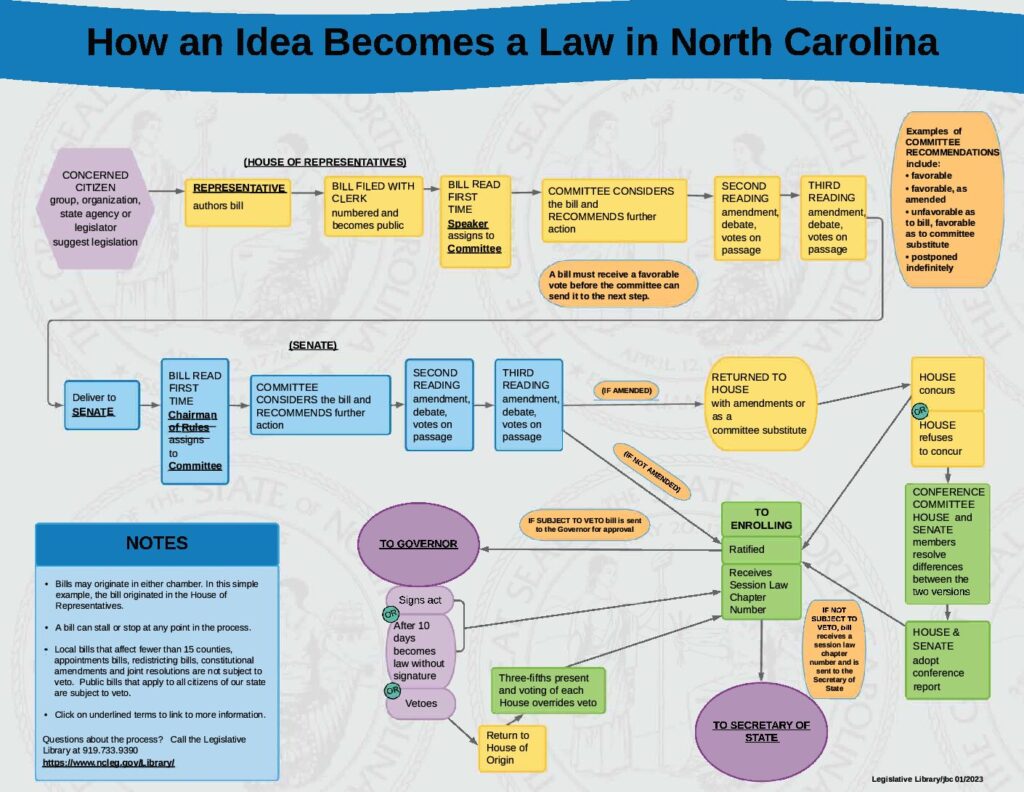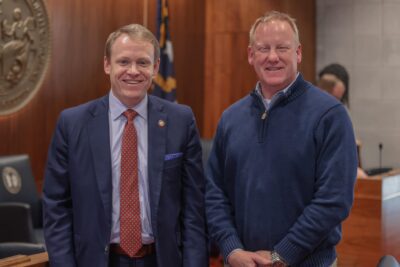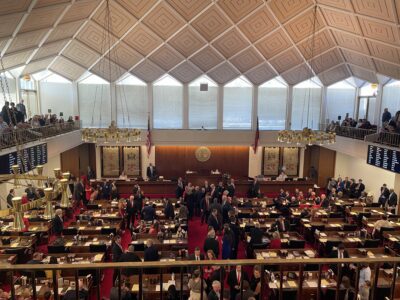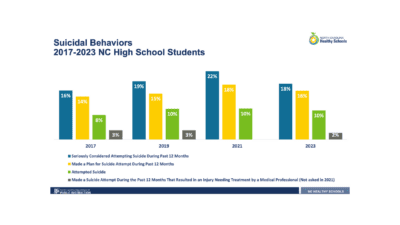
|
|
Welcome to a comprehensive guide to the North Carolina state government. Below is everything you need to know if you want to understand (and participate in) the process of governance.
A new legislative long session is kicking off this year, which you can learn more about below. Throughout the session, EdNC will report on key discussions, motions, bills, laws, and advocacy that could impact public schools across North Carolina.
Much of the information in this article is sourced from the North Carolina constitution and relevant state government websites.
Stay tuned for reporting on the legislature from our team of reporters: Hannah, Ben, Liz, and Chantal. You can find all of EdNC’s coverage during the 2025 legislative session here.
Here are some important dates to know:
- Feb. 27: Senate Bill Drafting Deadline
- March 6: House Bill Drafting Deadline
- March 25: Senate Bill Filing Deadline
- April 10: House Bill Filing Deadline
- May 8: Bill Crossover Deadline
Legislative power
Article II of our state constitution vests legislative power in the N.C. General Assembly.
From 1898-2010, Democrats largely controlled the legislature. Republicans have held power since 2011.
Each session of the General Assembly in North Carolina convenes for two years — often referred to as a biennium. The current session is the “long” session, which started on Jan. 8. During this session, bills are introduced, and a two-year budget is adopted. Each biennium, the state House and Senate alternate which chamber takes the lead on budget legislation; this time around, it is the Senate.
Typically, the long session lasts until around July, although sometimes it stretches on longer. There is no statutory or constitutional requirement for when a session ends.
The “short” session will convene in spring 2026. Bills that have passed one house, recommendations from a study commission, and issues related to the budget are in play during the short session.
There are 120 members in the House of Representatives and 50 members in the Senate. All legislators in both houses serve two-year terms, and there are no term limits for legislators in North Carolina.
Those elected to the General Assembly serve part-time and often have other jobs back home. During session, they typically meet on Monday evenings, Tuesdays, Wednesdays, and Thursdays.
Both chambers — the House and the Senate — are in the Legislative Building. It is located at 16 West Jones Street in Raleigh. Rooms in the building have four digits (e.g. “1226”).
The Legislative Office Building, which houses many of the offices for legislators as well as larger committee rooms, is located across the street from the Legislative Building at 300 North Salisbury Street. There is a bridge over Lane Street that connects the two buildings. Rooms in the Legislative Office Building have three digits (e.g. “544”).
The House of Representatives
The speaker of the House is Destin Hall, R-Caldwell. He was newly elected as speaker this year and is serving his fifth term in the House.
Currently, there are 71 Republicans and 48 Democrats in the House, with one vacancy. There are 17 new members; 35 women members; 28 Black/African American members; one American Indian member; two Asian American members; and one Hispanic member. Here is a folder with member information, including seats, demographics, birthdays, military experience, representation by county, terms served, and occupations and education.
Here is information on House leadership. Here are office assignments. Here is information on committees. Information on bill deadlines can be found here (see rule 31.1).
The Senate
Rachel Hunt, a Democrat, is the lieutenant governor and president of the Senate. Though not a legislator, the lieutenant governor serves as the presiding officer of the Senate and has the power to vote when the members of the Senate are equally divided.
The president pro tempore of the Senate is Phil Berger, R-Rockingham. He has served as president pro tempore since 2011; this is his 13th term.
In the Senate, there are 30 Republicans and 20 Democrats. There are five new members; 16 women members; 10 Black/African American members; two Indian American members; and one Asian American member. Here is a folder with member information including seats, demographics, birthdays, military experience, representation by county, terms served, and occupations and education.
Here is information on Senate leadership. Here are office assignments. Here is information on committees. Information on bill deadlines can be found here (see rule 40.2).
Other things to know about the legislature
On the General Assembly’s website, both the House and Senate post their meeting calendars. Check there to see when bills are taken up in committees and on the floor. Plans are always subject to change as the session goes on.
Other factions that play key roles along the journey of a bill are the fiscal research division, the legislative drafting division, and the legislative analysis division.
This graphic lays out how a bill becomes a law in North Carolina.

One part of the lawmaking process is lobbying. A lobbyist is a person who works to influence legislators and political decisions. They are often hired by and act on behalf of specific organizations or people. Instructions on how to become registered as a lobbyist are here.
Executive power
Article III of the state constitution vests executive power in the governor. Here is the website for Gov. Josh Stein, a Democrat.
One part of the governor’s role in the long session is to propose a budget.
The governor has a few other powers. One is to issue executive orders. Here is where you can keep track of all executive orders. Another is the power to veto legislation. In fact, North Carolina’s governor was the last in the United States to receive veto power in 1996. Here is where you can see how many bills have been vetoed each session.
Unofficially, the governor can leverage their status as a public figure to sway North Carolina citizens into supporting or opposing legislation coming down the pipeline — also known as using the bully pulpit.
The Council of State includes the lieutenant governor, the secretary of state, the auditor, the treasurer, the superintendent of public instruction, the attorney general, and the commissioners of agriculture, labor, and insurance — all of which are elected positions. There are five Republicans and five Democrats (including the governor) on the Council of State.
Cabinet positions are appointed by the governor. These include the secretaries of administration, commerce, environmental quality, health and human resources, information technology, military and veterans affairs, natural and cultural resources, public safety, revenue, and transportation. The governor’s chief of staff, director of the office of state human resources, and the state budget director meet with the cabinet.
The governor also his his own staff, including Jonathan Krebs as his Western North Carolina Recovery advisor.
By statute, there is also an education cabinet. The governor serves as chair, and the education cabinet also includes the superintendent of public instruction, the chair of the State Board of Education, the president of the UNC System, the president of the N.C. Community College System, and the president of the N.C. Independent Colleges and Universities.
Agencies and offices to note
North Carolina has three independent executive agencies: the Office of Administrative Hearings, the Office of the State Controller, and the State Board of Elections.
The N.C. State Education Assistance Authority (NCSEAA) “is a political subdivision of the state, governed by a nine-member Board of Directors, with administrative support provided by the University of North Carolina.”
Here is the website of the Office of State Budget and Management. Kristin Walker is the state budget director.
Judicial power
Justices of the Supreme Court, judges of the Court of Appeals, and judges of the Superior Courts of North Carolina are all elected positions, all of which serve eight-year terms.
Currently, there is an ongoing legal battle surrounding the results of the 2024 NC Supreme Court elections. Read more about it here.
EdNC has also continuously covered the Leandro lawsuit which established a state constitutional right to access a sound, basic education.
Education
Section 4 of Article IX of our state constitution establishes the roles of the State Board of Education and the superintendent of public instruction. Here is the website of the State Board of Education, here are the members, and here are the meeting dates for 2025. Eric Davis is chair of the Board.
The superintendent of public instruction is Maurice “Mo” Green, a Democrat. Here is the website for the Department of Public Instruction.
Here is where you can find information about charter schools.
There is a Division of Non-Public Education in the state Department of Administration. Here you can find information about home schools, and here you can find information about private schools.
The federal government
The current acting secretary of the U.S. Department of Education is Denise Carter, pending U.S. Senate confirmation of Linda McMahon.
Local governments
North Carolina has 100 counties. Counties provide local funding for education.
There are 115 school districts, often referred to as LEAs or PSUs, or local education agencies and public school units, respectively.
Each district has an elected (partisan or nonpartisan) or appointed school board and a superintendent. Here is where you can explore information about all of North Carolina’s school districts.
Contact your representatives
As the long session ramps up, one of the most important things to know is how to find and contact your representatives so you can advocate and be a part of the legislative process. Here you can search for your representatives by your address.











